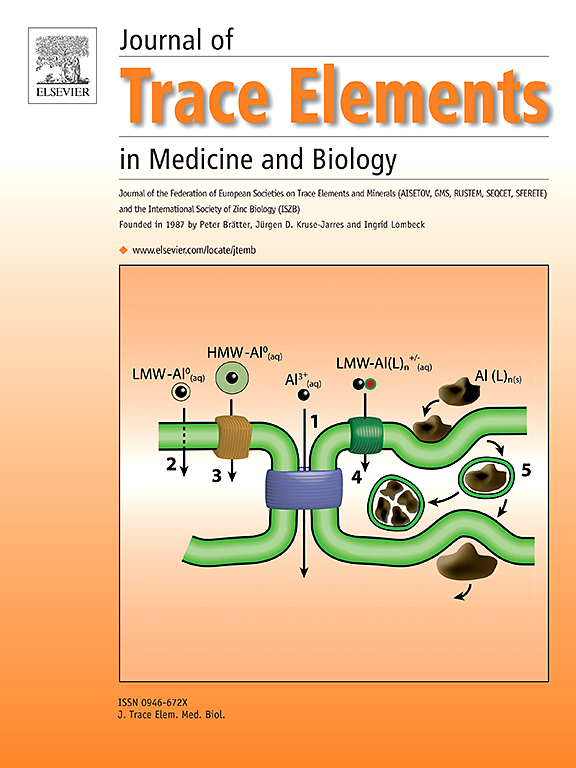Cerium-doped mesoporous bioactive glass nanoparticles reduce oxidative stress and adipogenic differentiation in human bone marrow-derived mesenchymal stromal cells
IF 3.6
3区 医学
Q2 BIOCHEMISTRY & MOLECULAR BIOLOGY
Journal of Trace Elements in Medicine and Biology
Pub Date : 2025-02-07
DOI:10.1016/j.jtemb.2025.127617
引用次数: 0
Abstract
Increased levels of reactive oxygen species (ROS) favor adipogenic over osteogenic differentiation in human bone-marrow derived mesenchymal stromal cells (BMSCs). Therefore, biomaterials containing ROS-suppressing elements such as Cerium (Ce) have been introduced to cell-based bone-tissue-engineering (BTE) approaches. This study was conducted to assess the efficacy of Ce-doped mesoporous bioactive glass nanoparticles (MBGNs) in reducing ROS levels and subsequently inhibiting the adipogenic differentiation of BMSCs. To this end, BMSCs were cultivated in adipogenesis inducing medium (AIM) and exposed to ions released from Ce-free MBGNs (composition in mol%: 86SiO2-14CaO), Low-Ce-MBGNs (composition in mol%: 86.6SiO2-12.1CaO-1.3CeO2) and High-Ce-MBGNs (composition in mol%: 86.0SiO2-11.8CaO-2.2CeO2). The influence of the different MBGNs on the expression of adipogenic and ROS-scavenging genes was assessed as well as their influence on lipid formation and the physical presence of ROS. Ce-MBGNs significantly reduced lipid production and the expression of adipogenic marker genes when compared to BMSCs cultivated in the presence of MBGNs or AIM alone. Furthermore, ROS levels were decreased by Ce-MBGNs alongside an upregulation of the expression of genes encoding for ROS-scavenging enzymes. Ce-MBGNs have proven their antioxidative potential. Mediated by the reduction of ROS, the undesired differentiation of BMSCs towards adipogenic lineage within BTE applications has been effectively suppressed. Ce-MBGNs target differentiation pathways in BMSCs precisely and therefore constitute an attractive biomaterial in the field of ion-based BTE.
掺铈的介孔生物活性玻璃纳米颗粒可降低人骨髓间充质间质细胞的氧化应激和脂肪分化
活性氧(ROS)水平的增加有利于人骨髓间充质间质细胞(BMSCs)的成脂分化而非成骨分化。因此,含有ros抑制元素如铈(Ce)的生物材料已被引入到基于细胞的骨组织工程(BTE)方法中。本研究旨在评估ce掺杂的介孔生物活性玻璃纳米颗粒(MBGNs)在降低ROS水平并随后抑制骨髓间充质干细胞成脂分化方面的功效。为此,在脂肪生成诱导培养基(AIM)中培养骨髓间充质干细胞,并将其暴露于无ce -MBGNs(成分摩尔%:86SiO2-14CaO)、低ce -MBGNs(成分摩尔%:86.6SiO2-12.1CaO-1.3CeO2)和高ce -MBGNs(成分摩尔%:86.0SiO2-11.8CaO-2.2CeO2)释放的离子中。评估了不同MBGNs对脂肪生成和ROS清除基因表达的影响,以及它们对脂质形成和ROS物理存在的影响。与单独存在MBGNs或AIM培养的骨髓间充质干细胞相比,Ce-MBGNs显著降低了脂质生成和脂肪生成标记基因的表达。此外,Ce-MBGNs降低了ROS水平,同时上调了编码ROS清除酶的基因的表达。Ce-MBGNs已被证明具有抗氧化潜力。在活性氧减少的介导下,BTE应用中不希望的骨髓间充质干细胞向脂肪生成谱系的分化已被有效抑制。Ce-MBGNs精确靶向骨髓间充质干细胞的分化途径,因此在离子基BTE领域是一种有吸引力的生物材料。
本文章由计算机程序翻译,如有差异,请以英文原文为准。
求助全文
约1分钟内获得全文
求助全文
来源期刊
CiteScore
6.60
自引率
2.90%
发文量
202
审稿时长
85 days
期刊介绍:
The journal provides the reader with a thorough description of theoretical and applied aspects of trace elements in medicine and biology and is devoted to the advancement of scientific knowledge about trace elements and trace element species. Trace elements play essential roles in the maintenance of physiological processes. During the last decades there has been a great deal of scientific investigation about the function and binding of trace elements. The Journal of Trace Elements in Medicine and Biology focuses on the description and dissemination of scientific results concerning the role of trace elements with respect to their mode of action in health and disease and nutritional importance. Progress in the knowledge of the biological role of trace elements depends, however, on advances in trace elements chemistry. Thus the Journal of Trace Elements in Medicine and Biology will include only those papers that base their results on proven analytical methods.
Also, we only publish those articles in which the quality assurance regarding the execution of experiments and achievement of results is guaranteed.

 求助内容:
求助内容: 应助结果提醒方式:
应助结果提醒方式:


